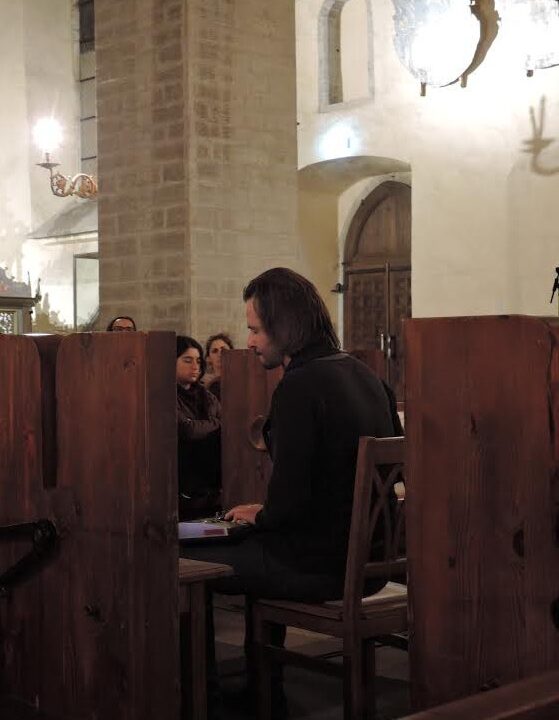
Concert of experimental music “Historical acoustics”.
On saksophone Michel Doneda (France).
Taavi Kerikmäe on electronics.
Producers: Prantsuse Instituut and IMPROTEST.
Two talented musicians, Taavi Kerikmäe and Michel Doneda, performed at St Nicholas Church on the 25th of November at midnight as part of the Festival Accord! 2014 and Improtest concerts. The performance was a unique experience between different periods of time, contemporary music with a medieval resonance.
During free improvisation, the Estonian Taavi Kerikmäe, who played the keyboard, and the French saxophonist Michel Doneda adapted their own style to the special environment where they were playing in. The interesting thing about this concert was how Taavi’s melody could be heard in real time through the speakers, spreading out every chord at the museum, which served as a resonance box. While he was experimenting his tech-music from his samplers, Michel was spinning around the nave of the church, to make the same in the purest way.
But what was the contemporary element in their music? The modern aspect in the music was the program that Taavi was using on his keyboard: a system developed by Scott Miller and based on Kyma. Kyma is a visual sound design environment, which uses graphical language for creating, modifying, and combining sounds in real time. It provides musicians with hundreds of basic modules and over a thousand examples that they can combine to create their own effects’ algorithms and their own forms of sample manipulation with responsive controls. Furthermore, it was also used as a tech-feedback for spatialization or, in other words, sounds that spread from the speakers were registered by microphones strategically located in order to adjust the best parameters for the resonance in the big and irregular building.
So, Taavi was playing the synthesis algorithms on his keyboard, using the timeline to schedule different effects processes at different times in his tablet, while the music was being generated in real time. All of those effects had been recorded by him beforehand, as part of the musique concréte style. However, Michel was trying the differences in the resonance by walking around the side aisles, the transept and the bay of the chapel, finding a nice harmony in the atonal context.
The concert was an inner paradox: the high technology used in the keyboard against the natural blowing saxophone, experimental music in a classic church, planned and measured algorithms against arrangement, and a meeting with musicians in the middle of the night during workdays.
To conclude, it was an unrepeatable, surprising and unexpected experience, where the naked sounds played by Michel Doneda perfectly combined with the new-born samples of Taavi Kerikmäe, creating a perfect marriage between free improvisation and experimental music, in a broken contemporary and mediaeval temporal-spatial line.
